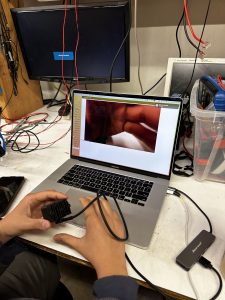We have officially completed all parts of our system so the only risk right now is if we cannot configure the system effectively to meet our pickup accuracy. We have been working hard to tune our system to detect items correctly and position itself to pickup; however, we are yet to find the sweet spot in our configuration that gets us the 80% threshold we want to achieve. The current contingency plan is to keep tuning it until it can detect the item correctly; we are experimenting with a few different item detection models still.
This week we reverted our design back to having the logic level shifters as well as a PMOS switch so we could reach the 7.4V input to the pumps. Through experimentation we proved that 7.4V was necessary to achieve our pickup weight of 700 grams. We will also be adding some extra weight to the rear of our design to make sure it does not tip over. Nathan is also working on developing a web page we can host with the camera feed; we found that this was the most effective way to be able to relay the camera feed back to the user side.
Here is the camera feed working.

Unit Tests Performed:
User Side Latency –> 10 ms Passed (5 trials timed/slomo camera)
Transmission Latency –> 15 ms Passed (5 trials timed/slomo camera)
Rover Side Latency –> 10 ms Passed (5 trials timed/slomo camera)
Lifting Capabilities –> 500 grams Failed –> 850 Grams Passed with 7.4V
Driving Speed –> 0.24 m/s Passed (5 trials measuring drive time across 1 meter)
Lifting time –> 8.4 seconds (calculated by timing lift across 70 trials)
Detection Accuracy –> 64% ish (calculated by 45 successful trials across 70)
Battery Life –> 1.25 hours of capacity (measured how much time we were able to perform tasks like driving/pickup)
Item Detection Range –> 33 cm (placed objects varying distances and found the maximum bound)

